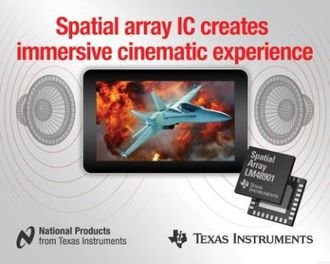Texas Instruments’ LM48901 is a quad Class D amplifier that utilizes Texas Instruments’ proprietary spatial sound processor to create an enhanced sound stage for portable multimedia devices. The Class D output stages feature Texas Instruments’ edge rate control (ERC) PWM architecture that significantly reduces RF emissions while preserving audio quality and efficiency. The LM48901’s flexible I²S interface is compatible with standard serial audio interfaces. A stereo differential-input ADC gives the device the ability to process analog stereo audio signals. LM48901 Datasheet
Features
- Spatial sound processing
- I²S compatible input
- Differential-Input Stereo ADC
- Edge rate control reduces EMI while preserving
audio quality and efficiency - Paralleled output mode
- Short circuit and thermal overload protection
Applications
- Laptops
- Tablets
- Desktop computers
- Sound bars
- Multimedia devices
- MP3 player accessories
- Docking stations
Texas Instruments has introduced an IC and design software that simplifies the implementation of spatially-enhanced audio in portable multi-speaker products.
Called the LM48901, the chip includes a sound processor and four 2W Class D amplifiers, and up to four of the ICs can be run together do drive up to 16 speakers. http://www.ti.com/spatial-pr
The chip introduces differential time delays and selectively filtering to direct sound and add psychoacoustic clues to the audio streams according to parameters pre-calculated by the accompanying design tool.
“We use beam forming and cross-talk cancellation to create a virtual headphone,” TI spatial audio engineer Eric Eklund told Electronics Weekly. “Than a head-related transfer function gives the impression of sound all around.”
So what does it sound like?
“I can get it to sound like sound is coming from any angle within 120° in front of you from speakers in a tablet computer,” said Eklund. “If you shut your eyes, you can not point to the actual speakers.”
To set-up the system for a particular product, engineers type the system geometry into the design tool.
“In programming the device, you input the position of the speakers and then you input the position of the listener,” said Eklund. “It is best if you can place the speakers in a horizontal line. It doesn’t have to be perfectly straight, but the closer the better.”
“If customer is using four speakers in their middle-range product, they can re-use almost all of their design effort if they make a high-end version with eight speakers,” he added.
At power-up, the parametric data is downloaded into the chip or chips, cascading through them if there is more than one.
In operation, all four, eight or 16 channels run in parallel with their individual pre-programmed delays and filter characteristics creating the final sound stage.
For more read: TI adds spatial audio to tablet computers

